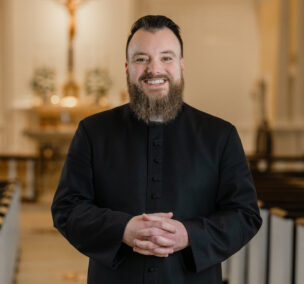Dear Brothers and Sisters in Christ,
The Church’s liturgical year begins today with our entrance into the preparatory season of Advent. Like the season of Lent, these four weeks are marked by a spirit of penance, though, as you know, that penance is traditionally different in its expression in this time leading to the celebration of the Nativity of the Lord. While the penance of Lent is marked by fasting and atonement for sin, the penance of Advent is marked more by the self-control required to restrain our joy as we anticipate the coming of Christ. Restrained joy is not joy denied; rather, our joy is meant to build and find its full voice and expression on Christmas Day. The Church gives us some liturgical practices that help this joyful anticipation build. We will examine some of these here as they provide a framework for the whole celebration of this great season.
The Gloria (“Glory to God in the highest…”) is not sung during Advent, with the exception of the feast of St. Andrew and the solemnity of the Immaculate Conception. The name of this joyful hymn is taken from its first line, “Gloria in excelsis Deo,” which we know well from the Christmas hymn “Angels We Have Heard on High.” The Gloria is the hymn the shepherds heard the angels singing when they received news of the birth of Christ, so it makes sense that as we prepare for the birth of Christ, we refrain from singing those joyful words.
During Advent, the liturgical norms for the Roman Calendar state that musical instruments are to be used with greater moderation. While this does not mean that our singing is entirely without musical accompaniment, the restrained use of the organ and other instruments becomes an audible reminder of the character of our joy. As we do each year here at St. Pius X, in these weeks we will use Mass parts sung to the Gregorian chant tones in Latin. Use of the Gregorian chant tones is especially fitting in Advent and Lent as it is a form of music designed for a capella singing, and these seasons call for moderation in instrumental accompaniment. As I have written many times over the last six years, using these tones is also fitting because the Church called for all the faithful to be able to sing certain parts of the Mass in Latin at the Second Vatican Council and continues to call for this in the General Instruction of the Roman Missal.
Since the liturgical reforms that followed the Second Vatican Council, the Church has used a three-year cycle of readings on Sundays, and a two-year cycle of readings on weekdays. We are now in Year C of the Sunday readings and Year II of the weekday readings. As we reflect on Sacred Scripture, we remember that we are reading the Word of God, and that in this holy word, we find the story of our salvation contained. In the Advent season especially, the readings indicate to us the ways in which God has planned from the time of the fall of Adam and Eve to come to rescue fallen humanity and redeem us, in His love, from the tyranny of sin and death. The Bible is a story full of hope!
The hymns of the Advent season are beautiful. They are invitational – note how often the plea for the Lord to come to us is echoed. They are poetic – note how many images are evoked that give us insight into who Jesus is. They are Scriptural – note the repeated echoes of themes from the story of Creation, from the Prophets, and from Revelation. One hymn is specially suited to a particular time of Advent: O Come, O Come, Emmanuel. This famous song is a setting of the O Antiphons. From Dec. 17 – 23, the Church’s prayer includes these special antiphons, one for each day. O Come, O Come, Emmanuel combines them into one hymn. Because the O Antiphons are proper to the time after Dec. 17, you can expect to hear this hymn after that date. The Marian antiphon for the Advent and Christmas seasons is Alma Redemptoris Mater. A fuller explanation of this antiphon and the other Latin Mass parts can be found later in this bulletin.
One of the great hymns for Advent is People, Look East. In five verses, this hymn uses seasonal imagery in a profoundly spiritual key. Just as we prepare our homes and hearths to welcome guests, we are also reminded to prepare our hearts and souls for the greatest Guest we can welcome. Jesus is referred to in each verse as “Love,” for as 1 John 4:8 reminds us, “God is love.” With the refrain “People look east” the hymn calls us to look to the east, to look toward Love incarnate, and to welcome Him. I have written in the past about the practice of celebrating Mass ad orientem, toward the east. In truth, to offer Mass in this way is a visible demonstration of the union of the priest and the people praying together as they orient their lives toward Christ. Rather than People, look east, except the priest, when Mass is offered ad orientem priest and people together look to the east, to the Love that is coming into the world. For one weekend in Advent, I would like to invite you to experience worship in this way. The weekend Masses of the Third Sunday of Advent (Dec. 11-12) will be offered ad orientem.
All of the Church’s liturgical practices are intended to draw us more deeply into the mystery being celebrated. In Advent, the vestment colors, the simply decorated sanctuary, the moderate use of instrumental music, the Scriptures we read, all point us to the central fact that Christ is coming, that God desires to be united to His people. This is a season of great joy and anticipation and an opportunity for us to turn our minds and hearts to the Lord. To help us in this spiritual conversion to Jesus Christ, you are invited to an Advent morning of recollection here at St. Pius on Dec. 11, from 9:30 AM – 12:30 PM, led by Fr. Richard Cipolla. This will be an opportunity to reflect on God’s goodness to us and the welcome we can offer the Christ Child. May this new year of grace be filled with divine blessings and may this holy season help all of us to prepare a welcome for Christ our King.
Peace,
Fr. Sam


